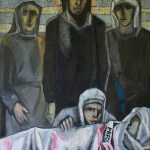
حقا ممكن הן אפשר
curators, Kamal Boullata, Yona Fischer
exhibition administrator, Shulamith Koenig.
exhibition catalog: Craryville, N.Y : New York Ad Hoc Committee of Artists & Writers for Israeli-Palestinian Peace
| “An exhibition of works on paper organized by the New York Ad Hoc Committee of Artists & Writers for Israeli-Palestinian Peace, Wednesday, October 12 – Sunday, November 20, 1988, The Great Hall Gallery, The Cooper Union for the Advancement of Science & Art.” |
Art Review: “It’s Possible”
Zeina Azzam SeikalyIn: 159 (July/August 1989)
It’s Possible, A Joint Exhibition of Palestinian and Israeli Art
“It’s Possible” is the theme of an exhibition by Palestinian and Israeli artists currently touring the United States. Twenty-four artists — 12 Palestinians and 12 Israelis — are displaying their works together in the first such effort outside Israel and the occupied territories. The exhibit curators are Kamal Boullata, a Palestinian artist and design editor of this magazine, and Yona Fischer, senior curator of the Israel Museum; New York-based Israeli sculptor Shulamith Koenig serves as the exhibition administrator.
Members of the Jerusalem-based Ad-Hoc Committee of Artists and Writers for Israeli-Palestinian Peace, which coordinated the exhibition, were among the more than 1,000 Israeli and Palestinian artists, writers, and academicians who signed a symbolic peace treaty on June 13, 1988. The document articulates the political underpinnings of the present exhibit, calling for (1) the creation, under international supervision, of an independent Palestinian state in the West Bank and Gaza Strip; (2) mutual recognition by the states of Palestine and Israel of the right to secure borders; (3) a peace treaty and non-aggression accord signed by the two states, with international guarantees; (4) a demilitarized Jerusalem that serves as the capital for both states; and (5) a just solution to the refugee problem.
In addition to the 24 artists in the exhibit, the signers of the treaty include a number of prominent Palestinians — writers Emil Habibi and Salim Jubran, poets Samih al-Qasim and Nazih Khair, actors Salim Daw and Makram Khoury, and Haifa University education professor Mariam Mar‘ — and Israelis — filmmaker Amos Gitai, playwright Dani Horvitz, writer Amos Kenan, Knesset member Matti Peled, sculptor
Igael Tumarkin, and poet Natan Zach. Poets Allen Ginsberg and Octavio Paz and artist Leon Golub are among many from the international literary and artistic community who have declared their support.
The art in the exhibition varies considerably in style, composition, and technique. Suleiman Mansour’s works, created with earth and paint, have a rough three-dimensional quality that evokes images of the villages and landscape of Palestine. David Reeb uses an acrylic medium in his abstract
depictions of Palestinian and Israeli subjects. Tsivi Geva’s four large, stark renderings of an Arab headdress (“Kafiya I-IV”) are creations in lacquer and spray. Boullata’s maze-like silkscreens of Arabic calligraphy speak of perfect symmetry and invite reflection.
Joint efforts of Palestinian and Israeli artists began in 1981, and several of those participating artists are in this US tour. In 1985, an “Art Against Occupation” exhibit featuring 20 Palestinian and 30 Israeli artists and 120 works toured Tel Aviv, Nazareth, Rameh, Jerusalem, and Haifa (see Al-Fajr, March 22,1985). In 1988 a number of Palestinian and Israeli artists organized an exhibit in Jerusalem dedicated to the memory of those killed during the intifada.
The US tour “is in the nature of a manifesto…the coming together of these artists represents a specific and political symbolic gesture that entailed considerable inner struggle and personal risk,” writes noted American art critic Dore Ashton, a New York Ad-Hoc Committee member, in the exhibition catalog. Count Wilhelm Wachtmeister, the Swedish ambassador to the United States who facilitated the meeting between Arafat and Jewish-American leaders last December in Stockholm, introduced the Washington, DC opening, which attracted over 500 persons, in similar terms: “In order to make peace, opponents must go to each other….The importance is that you meet, that we meet.”
The exhibit tour began in New York and traveled to Washington, DC, Chicago, San Francisco and Pittsburgh. It is scheduled to be in Seattle July 6-28 at the Cliff Michael Gallery, and plans are underway for displays in Philadelphia, Atlanta and Boston in the fall.
How to cite this article:
Zeina Azzam Seikaly “Art Review: “It’s Possible”,” Middle East Report 159 (July/August 1989).
source: Middle East Research and Information Project: Critical Coverage of the Middle East Since 1971



















